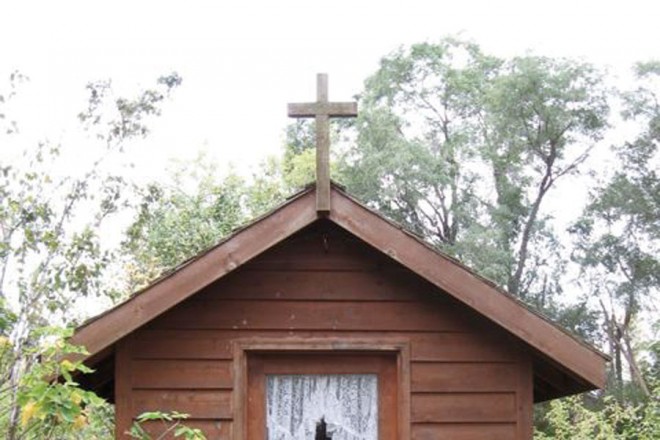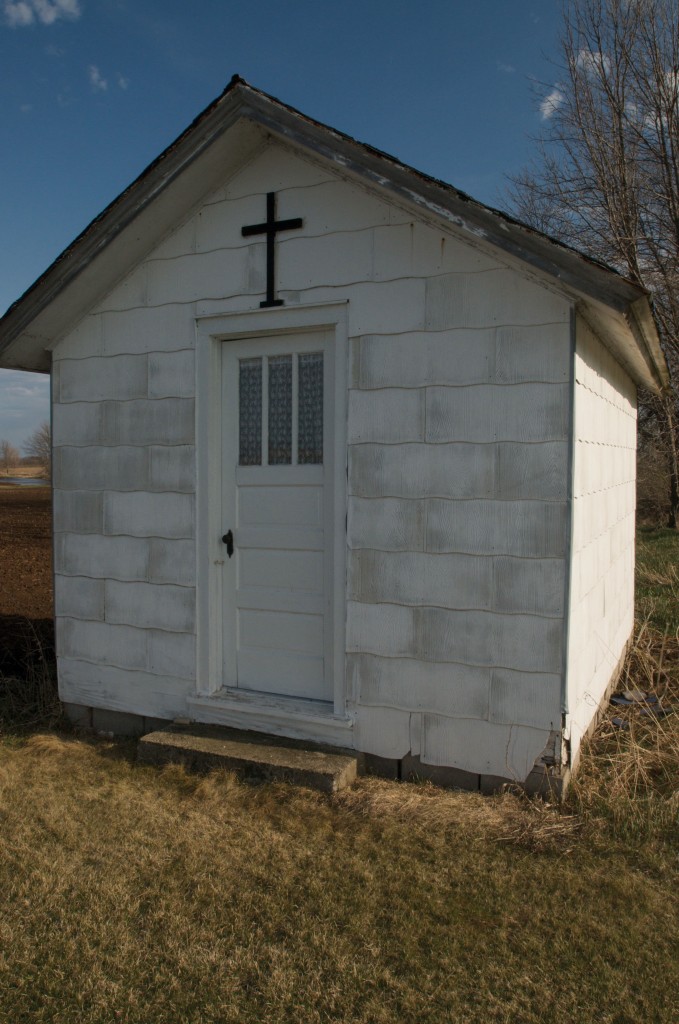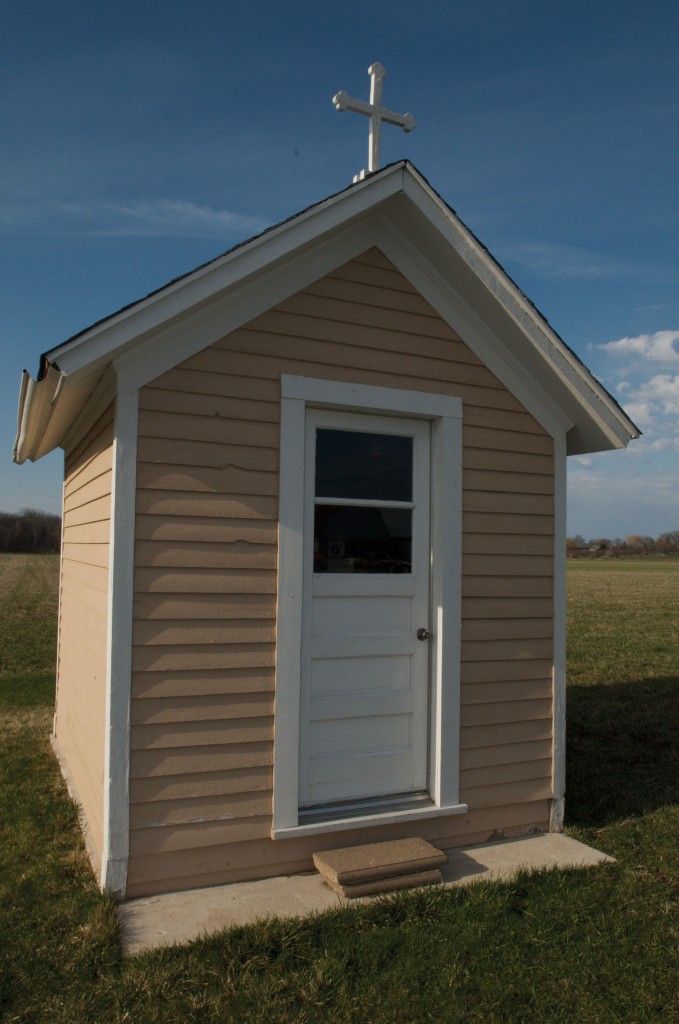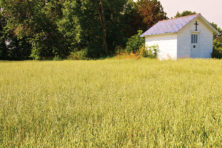Southern Door County’s Belgian Wayside Chapels
- Share
- Tweet
- Pin
- Share

Along the roadsides of southern Door County, in the heart of the Belgian-American settlement, an observant traveler might notice small unobtrusive buildings standing slightly apart from a brick farmhouse or painted red barn. These simple structures, built of wood and adorned with a cross on the roof or above the door, could easily be mistaken for a shed or even an outhouse. Rather, they are sacred spaces, roadside chapels erected by Belgian settlers and their descendants, never locked and open to all.
The Belgian Wayside Chapels are evidence of the historic faith of the Belgian settlers, and of the determination of their modern descendants to preserve the Belgian culture and way of life. Today, more than a dozen of these chapels are lovingly maintained, often by descendants of the families who built them.
Door, Brown, and Kewaunee counties contain the largest concentration of Belgian-Americans in North America. Walloon speaking Belgians arrived in the 1850s in great number, fleeing food shortages caused by a potato blight that had spread across Europe and cholera epidemics. More than 2,900 Belgians had settled in the area by 1860. They came to pursue the dream of land ownership, and bought their first homesteads for $1.25 per acre.
Today, according to Professor William Laatsch of the University of Wisconsin – Green Bay, as much as 80 percent of the property of these original settlers is still owned by their descendants. This continuity is remarkable in a world where so many Americans are highly mobile and far from their families’ geographical roots.

Inside the Chapel of Our Blessed Mother roadside chapel in southern Door County. Photo by Dan Eggert.
When the first Belgian settlers arrived in Northeastern Wisconsin, they put down roots at Bay Settlement just north of Green Bay and traveled miles on foot or horseback to attend mass with Father Edouard Daems, a French-speaking priest who was a leader and supporter of the early settlers. Many historical accounts refer to the strong Roman Catholic faith of these early settlers.
As more Belgians arrived, their settlements spread to areas we now know as Dykesville, Lincoln, Duvall, Rosiere, Brussels, and Namur. The new immigrants were no less devout, but could not travel long distances to mass every week. Father Daems celebrated mass in Brussels occasionally, but people also prayed in their homes and in the tiny chapels they constructed.
When they became able, the settlers built beautiful stone churches for entire congregations. These stand today in Brussels, Rosiere, Namur and many other hamlets. But before the Belgians had their own grand churches, many families built these small votive chapels as places of intimate worship and communion with God.
The chapels were located near roads for the convenience of travelers and pilgrims. They were modeled after the wayside chapels in the Ardennes, the southeastern area of Belgium from which the immigrants came. The chapels are invariably simple in design: a narrow altar dressed with religious statues, candles, and always a statue of the Virgin Mary. Each was built for a specific purpose, in thanksgiving for some blessing received, or with the hope of divine intervention in the health and life of a loved one.
One of southern Door County’s loveliest wayside chapels is St. Odile’s on Fox Lane off of County Road C north of Brussels. Built in 1870 by Joseph Destree, the chapel is unusual in that it is built of stone. Destree was a mason by trade and constructed many of the stone buildings in the area. One day he got lime in his eyes, and feared blindness. He prayed to St. Odile, the patron saint of good eyesight, who was born blind and then miraculously recovered her vision. When Destree was cured, he built the chapel in honor of her. Entries in the simple spiral notebook that serves as guest register attest to visitors almost daily from spring through fall. These pilgrims, people of faith, curiosity, or both, leave comments such as “I felt God here,” “Beautiful,” or “Thank you for this place.”
LeeAnn Destree LeRoy, a descendent of Joseph Destree, remembers the chapel’s restoration in the 1950s. Her uncle, Merton Destree, died at the age of 22. “He didn’t have much money, but what he did have, he set aside to do some repairs [on the chapel],” she says. LeAnn recalls her mother painting the interior of the chapel blue, and the stonework being repaired. As an adult, LeeAnn took her own children to the chapel when they were old enough to understand its significance. “When we had a few minutes extra, we’d go there. We prayed. Now we’ve taken our grandchildren there, too,” she relates. LeeAnn has created a book for her family about their heritage and history, including a section about the chapel on Fox Lane.
St. Odile’s is no longer owned by the Destree family. When asked who maintains the chapel, she replies “Nobody and everybody.” People in the community, including a woman who prays there regularly, see that the chapel is cared for. LeeAnn lives in Green Bay now, and whenever she and her husband are in the area, they try to stop by.
Just down the road from St. Odile’s is the Chapel of Our Lady of Perpetual Help on the Mark Jadin property on Ledge Road. Set a few yards from the road, the simple white clapboard structure looks solid, if slightly weather worn. It has the sturdy wooden door typical of a wayside chapel, with a small square window adorned with a white lace curtain. The first chapel on the site was built by Ernest Baudhuin in the 1800s in thanksgiving for his recovery from a serious accident. When the original chapel deteriorated, another was built by Mark Jadin’s grandfather, probably in the 1930s or ‘40s. Mark Jadin cared for the chapel for many years before his untimely death in a house fire last year.
A close friend and neighbor of Mark Jadin, Debbie Thayse of Brussels, says that Mark was always thinking ahead and considering how to preserve the structure. Before he died, Mark told Thayse that “he wanted me to have his chapel if anything happened to him.” Debbie often goes to the chapel to pray. “I go in there and think about Mark and ask him to help me know what to do.”
Debbie is considering moving the chapel to her own property nearby, to more easily care for it and watch visitors come and go. If she does, she plans to place a map at the former site so that visitors can find the new location.
Mary Ann Englebert, a fifth generation Belgian-American, and a historian in her own right, remembers regular walks to the Chapel of St. Roche, which then was located down the road from the family home where she was born. Mary Ann still lives in her birth home, now with her husband Donald and son Kevin.
“Every night in May, we’d go to the chapel, all the old ladies and the kids, and we’d say the rosary and the litany. Then we’d play baseball in the field there. Every night at 6:00,” she recalls. She shakes her head thoughtfully. “Nowadays there’s no time for things like that.”
May was a special time for worship because of Rogation Days. Rogation consists of solemn processions of the faithful within the boundaries of the parish to ask for help and mercy from God at planting time. Mary Ann remembers groups who would process along the roadsides to other chapels in the area.
“First the priests, then the altar boys, the ladies praying the rosary, and the men always in the back,” she relates. They would stop at chapels to pray, with a larger church or the chapel at Robinsonville as their final destination.
St. Roche’s is one of several chapels that has been moved for preservation. Now located behind the Belgian American Club in Namur, on the “curve” next to St. Mary of the Snows, it is maintained by club members who are proud to have it adjacent to the historic schoolhouse which serves as their meeting house.
The Chapel of Our Lady in Namur is the wayside chapel with which many travelers to Door County may be familiar. It is a white wooden shingled building with a cross above the door, and is located at the same curve in Namur, on old Highway 57, across the road from the well-known Belgian Bar. Jim Baudhuin, now in his seventies, recalls the chapel’s move from when he was a boy. The road was being widened, placing the chapel too close to the corner. Jim came home from school one day and found the chapel in its new location. “My grandpa, dad and my uncle jacked it up and rolled it across the road.” Though the chapel still sits on family property, Jim no longer maintains it himself. “A few years ago, some ladies came by and asked if they could take care of it,” he says.
Southern Door has recently seen the construction of two new chapels in the Belgian tradition. In 1992, Mary Ann and Donald Englebert and their son Kevin built a chapel on their property on County C in Brussels. The chapel memorializes Kevin’s sister Debbie who died in a snowmobile accident in 1973 at the age of 13. It also honors Mary Ann and Don’s parents, who instilled in them the deep faith that sustains and nourishes them through difficult times.
The Engleberts call their chapel La Petite Chapel la Sacra Crued (The Little Chapel of the Sacred Heart). Like the others it was modeled from, it contains a simple altar adorned with a statue of the Virgin Mary, some statuary, framed religious art, a plaque commemorating the building of the chapel, votive candles, and a kneeler. Don and Kevin built the chapel as a project when Kevin was being home schooled. Mary Ann visits the chapel every day the weather is good.
Mary Ann’s faith is also a practical faith:
“We thought about having the chapel face the road, but then we thought about the snowdrifts,” she said.
The door to the chapel faces their house and stands on their lawn a hundred yards or so from the road. Even so, it receives prayerful visitors from near and far, including visitors from Belgium who developed a sister city relationship with the Belgian community in the area.
A combination of deep faith and practicality also guided Jan and Norman Lacrosse who in 1992 built their chapel, named Our Lady Queen of Peace, in honor of the Virgin Mary. Jan and Norman raised a family of nine children and 30 foster children at their home on a hilltop on County Road D near Brussels. Like many other Belgian-Americans, Jan came from a religious and faith-filled family. She recalls making the pilgrimage as a child, on foot, to the chapel at Robinsonville each summer.
“We would leave at two, three in the morning and get there before the sun was too hot. When we got there, our legs felt like rubber. Then we would pray the novena nine times around the altar on our knees,” she recounts.
Jan and Norman were moved to build their chapel “in honor of the Blessed Mother for our many miracles and many blessings.” One of the many blessings Jan refers to is the fact that after being diagnosed with cancer in 1992, and again two years later, she went on to make a full recovery. “This chapel was meant to be,” she says.
They originally planned a small roadside chapel. “But then we thought about the snowplows,” laughs Jan. When their builder, Joseph Paye of Brussels, said he could build a larger chapel for nearly the same cost, the Lacrosses were thrilled. The construction went quickly and Jan and Norman worked to gather the exquisite artifacts now inside the chapel, which include stained glass windows from the now-closed St. Francis Monastery in Pulaski; statues, rosaries and artwork donated by various friends and neighbors; and pews from a Catholic church that had closed its doors. Every item in the chapel has a story. The stained glass windows from the monastery were discovered behind closed doors after they were believed missing. A striking life-sized statue of the Blessed Mother herself was purchased just after Jan had received an unexpected check in the mail. “It was just the amount of money I needed to buy it.” When asked how her Belgian heritage led her to the building of the chapel, Jan replies simply that her people are “faith-filled…prayerful.”
Places become and remain holy because they possess a certain beauty that connects the human with the divine. But perhaps holiness also comes from the spirit that is present in the acts of care that people show for a community’s places and history, and for each other. As Mary Ann Englebert wrote in her book Forever Yesterday We Were Young,
“Many people don’t understand and say w
e don’t need these external things to pray, and we know that. But it doesn’t hurt if these external things bring us closer to God and strengthen our faith. This was the strong faith our ancestors had.” Jan Lacrosse sums it all up when she looks around her beautiful chapel and says, “I don’t take credit for all of this. This was the Holy Spirit acting through me.”
Southern Door County’s Belgian Chapel Locations
- St. Odile’s Chapel, near the corner of Fox Lane and County Road C.
- Chapel of Our Lady of Perpetual Help, 10184 Ledge Road.
- Chapel of St. Roche, 1257 County Road DK.
- Chapel of Our Lady, 1298 Pit Rd.
- La Petite Chapel la Sacra Crued, 1453 County Road C.
- Chapel of Our Lady Queen of Peace, 9415 County Road D.
The Chapel at Robinsonville
The Chapel at Robinsonville, known as Our Lady of Good Help, has been a mecca for the faithful for 150 years. It honors the Virgin Mary, who is said to have appeared there several times in a vision of a young woman named Adele Brice. Adele was born in Belgium and immigrated to Wisconsin with her family. At the age of 28, she saw a vision of the Virgin Mary as she was walking to the mill with a sack of wheat on her head.
After seeing the apparition twice more, Adele was told by Mary to “gather the children in this wilderness and teach them what they should know of salvation.”
Both ridiculed and revered, Adele was fierce in her determination to follow her holy directive. In 1861, her father built the first chapel, a tiny log structure, but in years to come the chapel would be rebuilt several more times. Throughout its colorful history, the compound has housed a boa
rding school, a facility for disabled children, and a home to an order of contemplative nuns. The edifice that stands today is made of brick, and in the basement are hundreds of discarded crutches which have been left by the faithful who claim that they were healed at this holy place. August 15th, Assumption Day, is traditionally the day when many Belgians gathered at the chapel.
At the height of its popularity, a thousand horse teams were said to have brought families to the chapel grounds to see the procession of priests, young girls in white dresses, and congregants singing hymns and praying.




